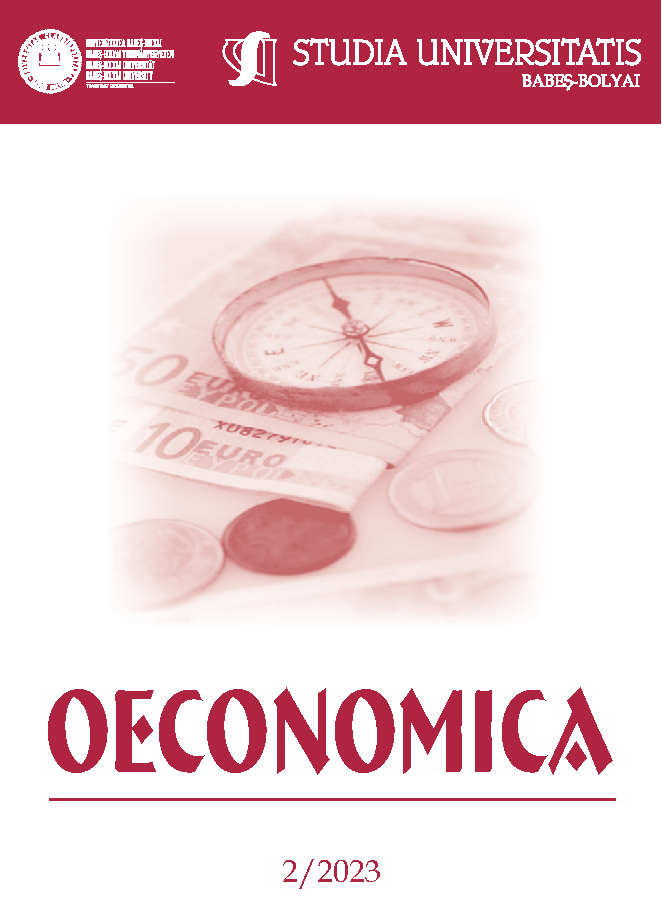THE NEXUS BETWEEN FOREIGN PORTFOLIO DIVERSIFICATION AND KINSHIP
DOI:
https://doi.org/10.2478/subboec-2023-0006Keywords:
international portfolio diversification, kinship, trust, financial literacyAbstract
This study seeks to understand the effect of kinship tightness of a society on foreign portfolio diversification. Using data for 42 home investor countries and 44 destination countries for the period of 2004-2021, it is found that investors from more tight-knit kinship societies tend to have smaller proportion of equities invested abroad, thus holding sub-diversified portfolios. The enforcement of these tight kinship societies is based on shame and communal values fostering local monitoring practices which leads to the absence of cooperation and trust, thus reducing stock market participation. It is further shown that kinship tightness can be shaped by enhanced financial literacy, which in turn fosters international diversification. On the other hand, loose kinship societies can be viewed as trust-promoting alternative mechanisms where formal institutions are less effective.
JEL classification: G15, G11, O16, Z10
References
Alesina, A., & Giuliano, P. (2013). Family ties. In Handbook of economic growth (Vol. 2, pp. 177-215). Elsevier.
Anderson, C. W., Fedenia, M., Hirschey, M., & Skiba, H. (2011). Cultural influences on home bias and international diversification by institutional investors. Journal of Banking & Finance, 35(4), 916-934.
Balloch, A., Nicolae, A., & Philip, D. (2015). Stock market literacy, trust, and participation. Review of Finance, 19(5), 1925-1963.
Beugelsdijk, S., & Frans, B. (2010). A cultural explanation of the foreign bias in international asset allocation. Journal of Banking & Finance, 34(9), 2121-2131.
Chan, K., Covrig, V., & Ng, L. (2005). What determines the domestic bias and foreign bias? Evidence from mutual fund equity allocations worldwide. The Journal of Finance, 60(3), 1495-1534.
Cox, D., Fafchamps, M., (2008). Extended family and kinship networks: Economic in- sights and evolutionary directions. Handb. Devel. Econ. 4, 3711–3784.
Dahlquist, M., Pinkowitz, L., Stulz, R. M., & Williamson, R. (2003). Corporate governance and the home bias. Journal of financial and quantitative analysis, 38(1), 87-110.
Dichtl, H., Drobetz, W., & Wendt, V. S. (2021). How to build a factor portfolio: Does the allocation strategy matter?. European Financial Management, 27(1), 20-58.
Driessen, J., & Laeven, L. (2007). International portfolio diversification benefits: Cross-country evidence from a local perspective. Journal of Banking & Finance, 31(6), 1693-1712.
Enke, B. (2019). Kinship, cooperation, and the evolution of moral systems. The Quarterly Journal of Economics, 134(2), 953-1019.
Ethan Ilzetzki, Carmen Reinhart and Ken Rogoff, Exchange Arrangements Entering the 21st Century: Which Anchor Will Hold? (2019). Quarterly Journal of Economics, 134(2), 599–646.
Fafchamps, M., Gubert, F., (2007). The formation of risk sharing networks. J. Devel. Econ. 83, 326–350 .
Fernández, A., Klein, M. W., Rebucci, A., Schindler, M., Uribe, M. (2016). Capital Control Measures: A New Dataset. IMF Economic Review, Palgrave Macmillan; International Monetary Fund, 64(3):548-574
Giannetti, M., & Koskinen, Y. (2010). Investor protection, equity returns, and financial globalization. Journal of Financial and Quantitative Analysis, 45(1), 135-168.
Giofré, M. (2017). Financial education, investor protection and international portfolio diversification. Journal of International Money and Finance, 71, 111-139.
Giuliano, P., & Nunn, N. (2013). The transmission of democracy: from the village to the nation-state (No. w18722). National Bureau of Economic Research.
Guiso, L., Haliassos, M., & Jappelli, T. (2003). Household stockholding in Europe: where do we stand and where do we go?. Economic Policy, 18(36), 123-170.
Guiso, L., Sapienza, P., & Zingales, L. (2008). Trusting the stock market. the Journal of Finance, 63(6), 2557-2600.
Hastings, J. S., & Mitchell, O. S. (2010). How financial literacy and impatience shape retirement wealth and investment behaviors. Michigan Retirement Research Center Research Paper, (2010-233), 2018-10.
Karolyi, G. A., Ng, D. T., & Prasad, E. S. (2020). The Coming Wave: Where Do Emerging Market Investors Put Their Money? Journal of Financial and Quantitative Analysis, 55(4), 1369-1414.
Klapper, L., & Lusardi, A. (2020). Financial literacy and financial resilience: Evidence from around the world. Financial Management, 49(3), 589-614.
Kwabi, F. O., Boateng, A. (2021). The effect of insider trading laws and enforcement on stock market transaction cost, Review of Quantitative Finance and Accounting, 56(3), 939–964.
Liu, Y. J., Meng, J., You, W., & Zhao, L. (2014). Word-of-mouth communication, observational learning, and stock market participation
Markowitz, H. (1952). Portfolio Selection J Finan 7:77–91.
Niu, G., Wang, Q., Li, H., & Zhou, Y. (2020). Number of brothers, risk sharing, and stock market participation. Journal of Banking & Finance, 113, 105757.
Petersen, M.A., (2009). Estimating standard errors in finance panel data sets: Comparing approaches. Rev. Financ. Stud. 22 (1), 435–480.
Portes, R., & Rey, H. (2005). The determinants of cross-border equity flows. Journal of international Economics, 65(2), 269-296.
Poshakwale, S. S., & Thapa, C. (2011). Investor protection and international equity portfolio investments. Global finance journal, 22(2), 116-129.
Putterman, L., & Weil, D. N. (2010). Post-1500 population flows and the long-run determinants of economic growth and inequality. The Quarterly journal of economics, 125(4), 1627-1682.
Rogers, Everett M. (2003). Diffusion of innovations, 5th ed. New York: Free Press.
Ronen, S., & Shenkar, O. (2013). Mapping world cultures: Cluster formation, sources and implications. Journal of International Business Studies, 44, 867-897.
Siegel, J. I., Licht, A. N., & Schwartz, S. H. (2011). Egalitarianism and international investment. Journal of Financial Economics, 102(3), 621-642.
Spolaore, E., & Wacziarg, R. (2009). The diffusion of development. The Quarterly journal of economics, 124(2), 469-529.
Spolaore, E., & Wacziarg, R. (2016). Ancestry, language and culture. Palgrave Macmillan UK, 174-211.
Van Rooij, M., Lusardi, A., & Alessie, R. (2011). Financial literacy and stock market participation. Journal of Financial economics, 101(2), 449-472
Downloads
Published
How to Cite
Issue
Section
License
Copyright (c) 2023 Studia Universitatis Babeș-Bolyai Oeconomica

This work is licensed under a Creative Commons Attribution-NonCommercial-NoDerivatives 4.0 International License.






